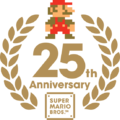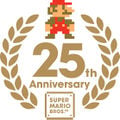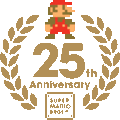User:Shokora/Help:Image: Difference between revisions
m (Robot: Automated text replacement (-plainlink +plain link)) |
m (Text replacement - "<center>(\n)?<gallery" to "<gallery") |
||
| Line 320: | Line 320: | ||
==File types== | ==File types== | ||
The exact same image has been converted into each of the four file types and placed within a gallery below. Their visual quality varies. | The exact same image has been converted into each of the four file types and placed within a gallery below. Their visual quality varies. | ||
<gallery> | |||
File:25th Anniversary Logo.png|'''PNG''' | File:25th Anniversary Logo.png|'''PNG''' | ||
File:Super Mario Bros 25th Anniversary Logo.svg|'''SVG''' | File:Super Mario Bros 25th Anniversary Logo.svg|'''SVG''' | ||
Revision as of 02:03, May 20, 2019
|
It is advised that any part of this user's own work is not copied and used on any other page. |
Help:Image
An image provides a visual example of an article subject. Images can be uploaded to the Super Mario Wiki by autoconfirmed users. Anonymous users who are not logged in or users who are not autoconfirmed will not be able to upload. This page goes into detail on image standards, uploading an image. and what users are able to do with an image once it has been uploaded.
Sourcing an image
Screenshots
- Main article: Help:Screenshot
Searching for pre-existing images
Before uploading, it is usually best to search for an identical or higher quality version that may already exist on the wiki. The best way to check is to take a look at the article/s that the image would be used on. Another good place to check is the gallery for the respective game that the image comes from. For example, Gallery:Super Mario 64 will contain many images from the game Super Mario 64. If you are unable to find it in either of these places, browse the image category. For example; Category:Super Mario 64 Images. If you find a similar image and the version you wish to upload is better, then it should be reuploaded. See below for more details.
If you can't find a similar image, then you are welcome to upload it as a new file.
Uploading
Uploading an image to the website means that it can be used on articles within a thumbnail or in a gallery. Images can also be linked externally, but if an image is to be used on an article or a then it must be uploaded. The following instructions outline the recommendations and basics when it comes to uploading an image.
Naming an image
(three pieces of info)
Using aboutfile
Categorizing
Image notices
Chosing a license
(table)
Upload options
Reuploading
Reverting to an earlier revision
(deleting revisions?)
How to upload
To upload an image to the site, first go to Special:Upload. You will see a form with many fields that must be correctly filled amongst three different sections. The first section is called "Source file", and it is where you can specify a file to upload. Here, users can choose to either upload from their computer or from a publicly accessible URL. The next section is called "File description". The first field in this section is the destination filename, which is what the name of the image will be when it has been uploaded. When you have selected a file from your computer, the filename will automatically appear in the field. The name can be adjusted if necessary.
One field down is the file summary, which is pre-coded with the {{aboutfile}} template. The usage of the template is optional, but it is recommended. Each of the five parameters of the template describes the file in a different way. They are:
- Subject - Give a brief description on what the file shows.
- Source - Where you found the file. This could refer to a website, method of obtaining (eg. YouTube screenshot), or the game it came from (if this wasn't already specified in the description.
- Artist - Here, the uploader can credit the person who created/scanned/procured the image.
- Edits - If the image has been edited from the source version, note the changes which were made.
An example code is as follows:
If you do not wish to use Aboutfile, then please remove the coding. Repeatedly leaving te tenplate uncoded and left on the file page is considered a minor offense, and a notice may be issued.
In the same field as Aboutfile, users can also add suitable image categories. An image should be categorized by the game it appears in (if applicable). For example, [[:Category:Super Mario World Images|]]. If the image is from a beta version of a game, add Category:Beta Images as well as the game category. Asides from categories, a suitable notice template can also be applied. They can be placed either above or below Aboutfile. A notice template's purpose is to bring attention to a certain problem or situation. Some types of files that may require a notice template include:
- Personal images - An image not intended for use on the wiki's articles, but rather your userspace, should be tagged with {{personal-image|Your username}}. If the image is to be used in a signature, type {{personal-image-sig|Your username}}.
- Issues with image quality - Sometimes, the best image available is of poor quality. This may be because it's blurry, unclear, has washed-out or incorrect coloring, or simply too small (an exception to official game sprites). In such cases, {{image-quality}} can be tagged on the file page, which requests for a better quality version of the image to be uploaded.
- Not unused - Images which are uploaded and linked externally, usually through a user's CSS, will appear as unused on the file page. To avoid misunderstandings with other users, TEMPLATE can be used.
- Imagemap -
Directly below the Aboutfile field is the licensing drop-down menu. Here, you can select an appropriate license to tag the image with. Every file should have a license, the reason being is that most images are copyrighted by Nintendo,........................
If you make a mistake with anything in the aboutfile field or the image license when uploading, remember that they can be modified by clicking the "edit" tab at the top of the file page. The next section of the form is the "Upload options". There are two checkboxes, the first asks if you wish to add the file to your watchlist. This means that if the file is modified, the page will appear bolded on recent changes and will be displayed on your watchlist. The second checkbox asks if you want to ignore any "warnings" which may appear when trying to upload a file. These warnings may be seen when an exact duplicate already exists on the wiki, or if the filename is already being used on an existing file. Generally, it is recommended that this is remained unchecked, unless the duplicate upload is intentional for whatever reason. When the warning is not bypassed, users will se
So, when you have completed the form, you are now ready to upload. Simply click on the "Upload file" link, and wait for the page to load. Depending on how large the file size is, the amount of time it takes to upload will vary. Once it has been uploaded, you can go and put it on an article.
Reuploading
If you have found a higher quality or more suitable version of an image already on the wiki, then we recommend that you perform a reupload. This involves overwriting an image with a newer version. To successfully reupload an image, the file type of both the old and new version of the file must match. If an image is protected, the page content and image can only be modified/overwritten by an administrator.
Every (unprotected) file page has a link near the bottom which reads "Upload a new version of this file". The procedure that follows is much like uploading a file as normal, except that the "Licensing" drop down menu does not appear. The main field where the Aboutfile code is seen should be used to describe the file changes. Whatever is filled here will only appear in the file history, not the file page itself. So filling out Aboutfile like you would with a new upload is not necessary. Instead, please leave a short description of the file changes. For example; "larger" or "better quality". When this has been done, click the "Upload file" link and wait for the page to load.
On most browsers, the new image may not immediately overwrite the old one. What usually appears is the old image with the dimensions of the newer one. Immediately after uploading, you should always clear the cache by refreshing the page, so the new version of the image appears. It would also be a good idea to refresh a few of the article pages where the image is placed on.
Using an image
Our articles just wouldn't be the same without the thousands of images uploaded to the wiki. As an uploader, you would be the one expected to use any images which have been uploaded by you, so it is crucial to know how to do so correctly. Even before uploading, you should be thinking about where the images could be used. Images related to the Mario series should primarily be placed on the relevant article/s relating to the image content. As well as this, the image may also go on the gallery for the character or game where the image comes from. An image may also be uploaded for use on a template or MarioWiki page, provided that the image in question is relevant to the content (you may need admin-approval before doing so). If your image isn't intended for usage on the main project, but rather on your userpage or in your signature, then you must tag it with {{Personal-image|Your Username}}.
Using a single image
| Result | Wiki coding used | Notes |
|---|---|---|
| [[File:Mushroom Example.png|75px|left]] |
| |
| [[File:Mushroom Example.png|75px|left|Click here!]] |
| |
| [[File:Mushroom Example.png|75px|left|Click here!|link=Super Mushroom]] |
| |
| [[File:Mushroom Example.png|75px|border|left|Click here!]] |
| |
| [[File:Mushroom Example.png|75px|thumb|left]] |
| |
| [[File:Mushroom Example.png|75px|thumb|left|Caption.]] |
| |
| [[File:Mushroom Example.png|50px|thumb|left|Caption.]] |
| |
| [[File:Mushroom Example.png|frame|left|Caption.]] |
| |

|
http://www.mariowiki.com/images/0/08/Mushroom_Example.png |
|

|
[http://www.mariowiki.com/Super_Mushroom http://www.mariowiki.com/images/0/08/Mushroom_Example.png] |
|

|
{{plain link|1=[http://www.mariowiki.com/Super_Mushroom http://www.mariowiki.com/images/0/08/Mushroom_Example.png]}} |
|
Using multiple images together
| Result | Wiki coding used | Notes |
|---|---|---|
|
{{multiframe |
| |
|
{{multiframe |
| |
Caption. |
{{multiframe |
|
|
{{multiframe |
| |
|
{{multiple image |
| |
|
{{multiple image |
| |
|
{{multiple image |
|
Galleries
- Characters
Infoboxes
Image maps
Moving an image title
If necessary, a file name can be moved to a more suitable title by autoconfirmed users. This should be carried out when when a name is unspecific or inappropriate. Moving an image title is much like moving a page. Autoconfirmed users will find a "move" tab at the top of the page. Clicking this will open a page where you will be [TO FINISH]
After the title has been moved, a redirect is created (like with moving a page). Articles using the old version of the file name can still display the image, but it is recommended that all of the links are updated. On the new filename page, check the "What links here" section to view which pages are using the file.
When all links have been updated, the redirect can be tagged with {{Delete|File moved}}, and it will soon be deleted by an administrator.
To organise
Replacing and marking an image for deletion
Sometimes, an image may be deleted by mistake, such as through a misunderstanding with another user. In cases like these, an image may be undeleted by an administrator using the Special:Undelete tool.
(unused images)Sometimes, an image may be left unused. Usually this is because a user forgot to tag it for deletion after it was replaced, or it may have simply been forgotten. All unused files on the wiki can be seen at Special:UnusedFiles.
Replacing an image
An image may be replaced when a better quality image has been uploaded as a separate file. Usually, a file can just be reuploaded, but as aforementioned, the file types must match. You can't reupload an existing PNG with a JPEG for example. If you have obtained a better quality PNG of an existing JPEG file, please don't switch the PNG to JPEG just to suit a reupload, as this will lower the quality and any (official) transparency will be lost. Instead, you can upload the better quality PNG version as a new file. This is known as replacing.
To correctly replace an image, you should check what pages the old file is being used on by looking at the "What links here" section of the file page. Go through the articles listed and replace the old image with the newer version by changing the file name on the articles. If the old file links to a userspace page other than your own, then please disregard it. It is up to users to maintain their own page and update the file link. Please also disregard files which link to talk pages. If an article is protected, then please contact an administrator or post a comment in this forum thread for assistance. When the old file has no more articles linking to it, then it may be tagged for deletion. You can do this by putting {{Delete|Replaced}} on the file page. It may also be a good idea to provide a link to the newer file, so the administrator who is deleting the file knows what it's being replaced by.
File types
The exact same image has been converted into each of the four file types and placed within a gallery below. Their visual quality varies.

 sign signifies that the image may be displayed at a modified size, and it could be enlarged by clicking on this symbol.
sign signifies that the image may be displayed at a modified size, and it could be enlarged by clicking on this symbol.
 " beside the image (which will show by default when linking images using a URL).
" beside the image (which will show by default when linking images using a URL).


